当您的业务数据存储在MongoDB中,并且需要进行语义分析和大图展示时,可借助阿里云Elasticsearch实现全文搜索、语义分析、可视化展示等。本文介绍如何通过Monstache将MongoDB数据实时同步至阿里云Elasticsearch,并对数据进行分析及展示。
背景信息
本文以解析及统计热门电影数据为例,提供的解决方案可以帮助您完成以下需求:
通过Monstache快速同步及订阅全量或增量数据。
将MongoDB数据实时同步至高版本Elasticsearch。
解读Monstache常用配置参数,应用于更多的业务场景。
方案优势
MongoDB、阿里云Elasticsearch及Monstache服务部署在专有网络VPC(Virtual Private Cloud)内,所有数据私网通信,高速且安全。
Monstache基于MongoDB的oplog实现实时数据同步及订阅,支持MongoDB与高版本Elasticsearch之间的数据同步,同时支持MongoDB的变更流和聚合管道功能,并且拥有丰富的特性。
Monstache不仅支持软删除和硬删除,还支持数据库删除和集合删除,能够确保Elasticsearch端实时与源端数据保持一致。
操作流程
准备同一专有网络下的阿里云MongoDB实例、阿里云Elasticsearch实例和ECS实例。其中ECS实例用来安装Monstache。
说明请准备版本兼容的Monstache工具、阿里云Elasticsearch和MongoDB实例,版本兼容性详情请参见Monstache version。
在ECS实例中安装Monstache,用来将MongoDB中的数据同步至阿里云Elasticsearch。安装前需要先配置Go环境变量。
修改默认的Monstache配置文件,在配置文件中指定MongoDB和Elasticsearch的访问地址、待同步的集合、Elasticsearch的用户名和密码等参数。配置完成后,运行Monstache服务,即可将MongoDB中的数据实时同步至阿里云Elasticsearch中。
分别在MongoDB数据库中添加、更新、删除数据,验证数据是否实时同步。
在Kibana控制台中,分析数据并使用Pie图展示分析结果。
步骤一:环境准备
创建阿里云Elasticsearch实例,并开启实例的自动创建索引功能。
具体操作步骤请参见创建阿里云Elasticsearch实例和配置YML参数。本文使用的实例版本为通用商业版6.7。
创建阿里云MongoDB实例,并准备测试数据。
具体操作步骤请参见MongoDB快速入门。本文以4.2版本的副本集MongoDB实例为例,部分数据如下。
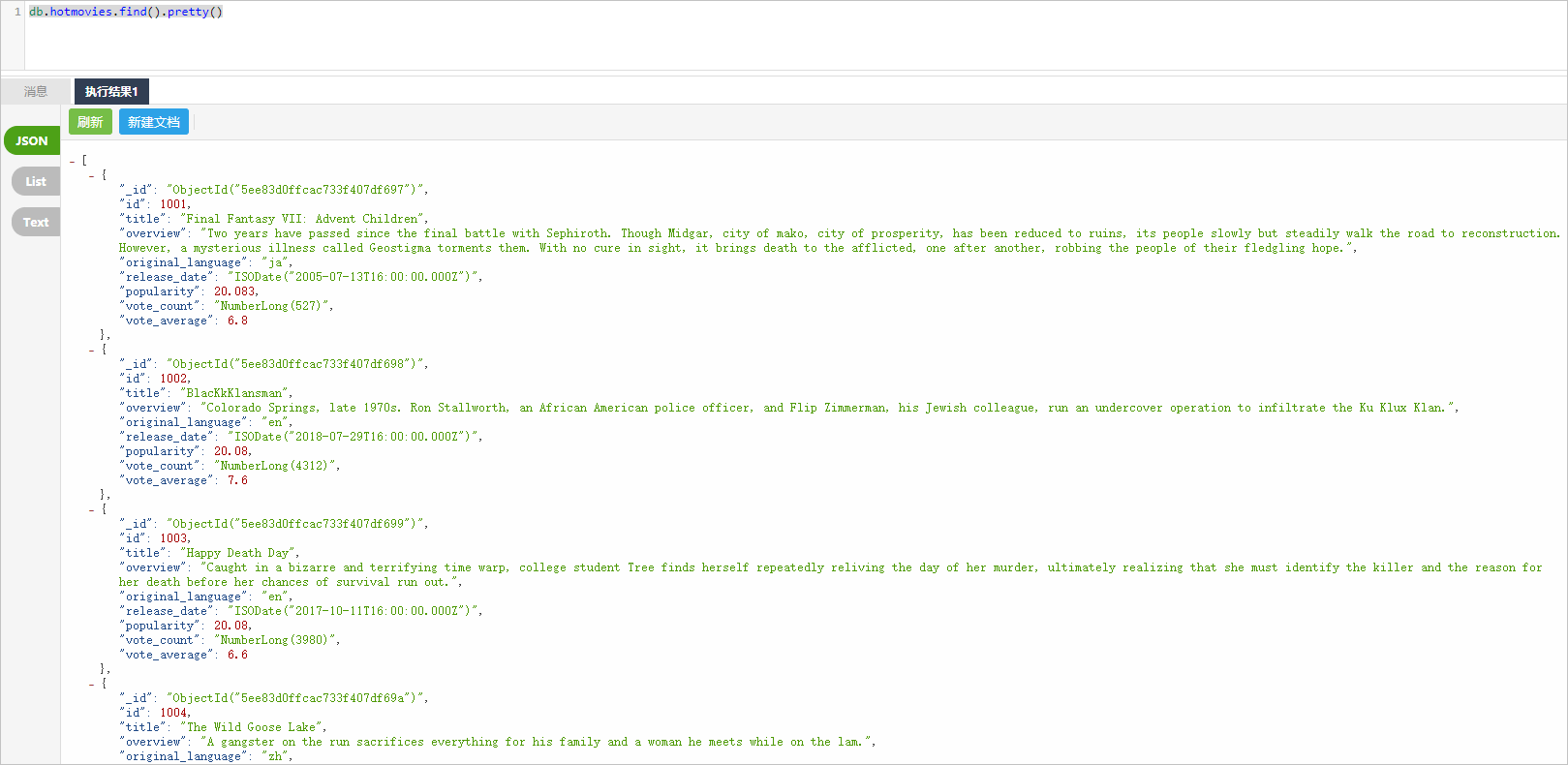 重要
重要MongoDB实例必须是副本集或分片集架构,不支持单节点架构。
创建ECS实例。
具体操作步骤请参见自定义购买实例。该ECS实例用来安装Monstache,需要与阿里云Elasticsearch实例在同一专有网络下,且选择Linux操作系统。
步骤二:搭建Monstache环境
连接ECS实例。
具体操作请参见通过密码或密钥认证登录Linux实例。
说明本文档以普通用户权限为例。
安装Go,并配置环境变量。
说明由于Monstache数据同步依赖于Go语言,因此需要先在ECS中准备Go环境。
下载Go安装包并解压。
wget https://dl.google.com/go/go1.14.4.linux-amd64.tar.gz tar -xzf go1.14.4.linux-amd64.tar.gz配置环境变量。
使用
vim ~/.bash_profile命令打开环境变量配置文件,并将如下内容写入该文件中。其中GOPROXY用来指定阿里云Go模块代理。export GOROOT=/home/test1/go export GOPATH=/home/go/ export PATH=$PATH:$GOROOT/bin:$GOPATH/bin export GOPROXY=https://mirrors.aliyun.com/goproxy/应用环境变量配置。
source ~/.bash_profile
安装Monstache。
从Git库中下载安装包。
git clone https://github.com/rwynn/monstache.git说明如果出现
git: command not found的错误提示,需要先执行sudo yum install -y git命令安装Git。进入monstache目录。
cd monstache切换版本。
本文以rel5版本为例。
git checkout rel5安装Monstache。
sudo go install查看Monstache版本。
monstache -v执行成功后,预期结果如下。
5.5.5
步骤三:配置实时同步任务
Monstache配置使用TOML格式,默认情况下,Monstache会使用默认端口连接本地主机上的Elasticsearch和MongoDB,并追踪MongoDB oplog。在Monstache运行期间,MongoDB的任何更改都会同步到Elasticsearch中。
由于本文使用阿里云MongoDB和Elasticsearch,并且需要指定同步对象(mydb数据库中的hotmovies和col集合),因此要修改默认的Monstache配置文件。修改方式如下:
进入Monstache安装目录,创建并编辑配置文件。
cd monstache vim config.toml参考以下示例,修改配置文件。
简单的配置示例如下,详细配置请参见Monstache Usage。
# connection settings # connect to MongoDB using the following URL mongo-url = "mongodb://<your_mongodb_user>:<your_mongodb_password>@dds-bp1aadcc629******.mongodb.rds.aliyuncs.com:3717" # connect to the Elasticsearch REST API at the following node URLs elasticsearch-urls = ["http://es-cn-mp91kzb8m00******.elasticsearch.aliyuncs.com:9200"] # frequently required settings # if you need to seed an index from a collection and not just listen and sync changes events # you can copy entire collections or views from MongoDB to Elasticsearch direct-read-namespaces = ["mydb.hotmovies","mydb.col"] # if you want to use MongoDB change streams instead of legacy oplog tailing use change-stream-namespaces # change streams require at least MongoDB API 3.6+ # if you have MongoDB 4+ you can listen for changes to an entire database or entire deployment # in this case you usually don't need regexes in your config to filter collections unless you target the deployment. # to listen to an entire db use only the database name. For a deployment use an empty string. #change-stream-namespaces = ["mydb.col"] # additional settings # if you don't want to listen for changes to all collections in MongoDB but only a few # e.g. only listen for inserts, updates, deletes, and drops from mydb.mycollection # this setting does not initiate a copy, it is only a filter on the change event listener #namespace-regex = '^mydb\.col$' # compress requests to Elasticsearch #gzip = true # generate indexing statistics #stats = true # index statistics into Elasticsearch #index-stats = true # use the following PEM file for connections to MongoDB #mongo-pem-file = "/path/to/mongoCert.pem" # disable PEM validation #mongo-validate-pem-file = false # use the following user name for Elasticsearch basic auth elasticsearch-user = "elastic" # use the following password for Elasticsearch basic auth elasticsearch-password = "<your_es_password>" # use 4 go routines concurrently pushing documents to Elasticsearch elasticsearch-max-conns = 4 # use the following PEM file to connections to Elasticsearch #elasticsearch-pem-file = "/path/to/elasticCert.pem" # validate connections to Elasticsearch #elastic-validate-pem-file = true # propagate dropped collections in MongoDB as index deletes in Elasticsearch dropped-collections = true # propagate dropped databases in MongoDB as index deletes in Elasticsearch dropped-databases = true # do not start processing at the beginning of the MongoDB oplog # if you set the replay to true you may see version conflict messages # in the log if you had synced previously. This just means that you are replaying old docs which are already # in Elasticsearch with a newer version. Elasticsearch is preventing the old docs from overwriting new ones. #replay = false # resume processing from a timestamp saved in a previous run resume = true # do not validate that progress timestamps have been saved #resume-write-unsafe = false # override the name under which resume state is saved #resume-name = "default" # use a custom resume strategy (tokens) instead of the default strategy (timestamps) # tokens work with MongoDB API 3.6+ while timestamps work only with MongoDB API 4.0+ resume-strategy = 0 # exclude documents whose namespace matches the following pattern #namespace-exclude-regex = '^mydb\.ignorecollection$' # turn on indexing of GridFS file content #index-files = true # turn on search result highlighting of GridFS content #file-highlighting = true # index GridFS files inserted into the following collections #file-namespaces = ["users.fs.files"] # print detailed information including request traces verbose = true # enable clustering mode cluster-name = 'es-cn-mp91kzb8m00******' # do not exit after full-sync, rather continue tailing the oplog #exit-after-direct-reads = false [[mapping]] namespace = "mydb.hotmovies" index = "hotmovies" type = "movies" [[mapping]] namespace = "mydb.col" index = "mydbcol" type = "collection"参数
说明
mongo-url
MongoDB实例的主节点访问地址,可在实例的基本信息页面获取。其中
<your_mongodb_user>为您使用的MongoDB实例的数据库账号,<your_mongodb_password>为对应数据库账号的密码。获取前需配置MongoDB实例的白名单,即在白名单中添加安装Monstache的ECS实例的内网IP地址,详情请参见设置白名单。
elasticsearch-urls
阿里云Elasticsearch实例的访问地址,格式为
http://<阿里云Elasticsearch实例的私网地址>:9200。阿里云Elasticsearch实例的私网地址可在实例的基本信息页面获取,详情请参见查看实例的基本信息。direct-read-namespaces
指定待同步的集合,详情请参见direct-read-namespaces。本文同步的数据集为mydb数据库下的hotmovies和col集合。
change-stream-namespaces
如果要使用MongoDB变更流功能,需要指定此参数。启用此参数后,oplog追踪会被设置为无效,详情请参见change-stream-namespaces。
namespace-regex
通过正则表达式指定需要监听的集合。此设置可以用来监控符合正则表达式的集合中数据的变化。
elasticsearch-user
访问阿里云Elasticsearch实例的用户名,默认为elastic。
重要实际业务中不建议使用elastic用户,这样会降低系统安全性。建议使用自建用户,并给予自建用户分配相应的角色和权限,详情请参见通过Elasticsearch X-Pack角色管理实现用户权限管控。
elasticsearch-password
对应用户的密码。elastic用户的密码在创建实例时指定,如果忘记可进行重置,重置密码的注意事项和操作步骤请参见重置实例访问密码。
elasticsearch-max-conns
定义连接Elasticsearch的线程数。默认为4,即使用4个Go线程同时将数据同步到Elasticsearch。
dropped-collections
默认为true,表示当删除MongoDB集合时,会同时删除Elasticsearch中对应的索引。
dropped-databases
默认为true,表示当删除MongoDB数据库时,会同时删除Elasticsearch中对应的索引。
resume
默认为false。设置为true,Monstache会将已成功同步到Elasticsearch的MongoDB操作的时间戳写入monstache.monstache集合中。当Monstache因为意外停止时,可通过该时间戳恢复同步任务,避免数据丢失。如果指定了cluster-name,该参数将自动开启,详情请参见resume。
resume-strategy
指定恢复策略。仅当resume为true时生效,详情请参见resume-strategy。
verbose
默认为false,表示不启用调试日志。
cluster-name
指定集群名称。指定后,Monstache将进入高可用模式,集群名称相同的进程将进行协调,详情请参见cluster-name。
mapping
指定Elasticsearch索引映射。默认情况下,数据从MongoDB同步到Elasticsearch时,索引会自动映射为
数据库名.集合名。如果需要修改索引名称,可通过该参数设置,详情请参见Index Mapping。说明Monstache支持丰富的参数配置,以上配置仅使用了部分参数完成数据实时同步,如果您有更复杂的同步需求,请参见Monstache config和Advanced进行配置。
运行Monstache。
monstache -f config.toml说明通过-f参数,您可以显式运行Monstache,系统会打印所有调试日志(包括对Elasticsearch的请求追踪)。
步骤四:验证数据同步结果
分别进入MongoDB的DMS控制台和阿里云Elasticsearch实例的Kibana控制台,查看同步前后对应文档的数量。
说明登录DMS控制台的方法请参见通过DMS连接MongoDB副本集实例。
登录Kibana控制台的方法请参见登录Kibana控制台。
MongoDB
db.hotmovies.find().count()预期结果如下。
[ 10000 ]阿里云Elasticsearch
GET hotmovies/_count预期结果如下。通过以下结果可以看到同步前后的文档的数量都为10000条。
{ "count" : 10000, "_shards" : { "total" : 5, "successful" : 5, "skipped" : 0, "failed" : 0 } }
在MongoDB数据库中插入数据,查看该数据是否同步到阿里云Elasticsearch实例中。
MongoDB
db.hotmovies.insert({id: 11003,title: "乘风破浪的程序媛",overview: "一群IT高智商女人,如何打破传统逆序IT精英",original_language:"cn",release_date:"2020-06-17",popularity:67.654,vote_count:65487,vote_average:9.9}) db.hotmovies.insert({id: 11004,title: "英姿飒爽的程序猿",overview: "一群IT高智商man,如何打破传统逆序IT精英",original_language:"cn",release_date:"2020-06-15",popularity:77.654,vote_count:85487,vote_average:11.9})阿里云Elasticsearch
GET hotmovies/_search { "query": { "bool": { "should": [ {"term":{"id":"11003"}}, {"term":{"id":"11004"}} ] } } }预期结果如下。
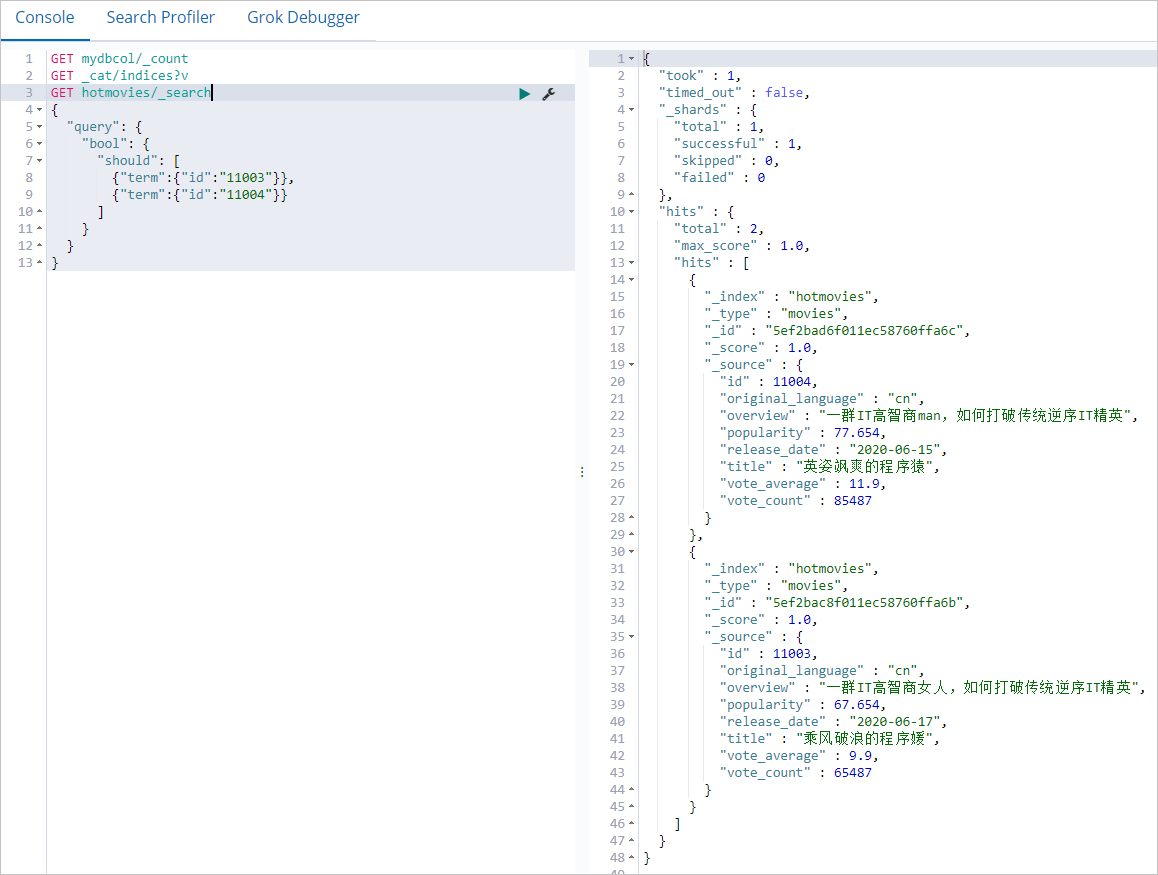
在MongoDB数据库中更新数据,查看阿里云Elasticsearch实例中对应的数据是否会同步更新。
MongoDB
db.hotmovies.update({'title':'乘风破浪的程序媛'},{$set:{'title':'美女小姐姐'}})阿里云Elasticsearch
GET hotmovies/_search { "query": { "match": { "id":"11003" } } }预期结果如下。
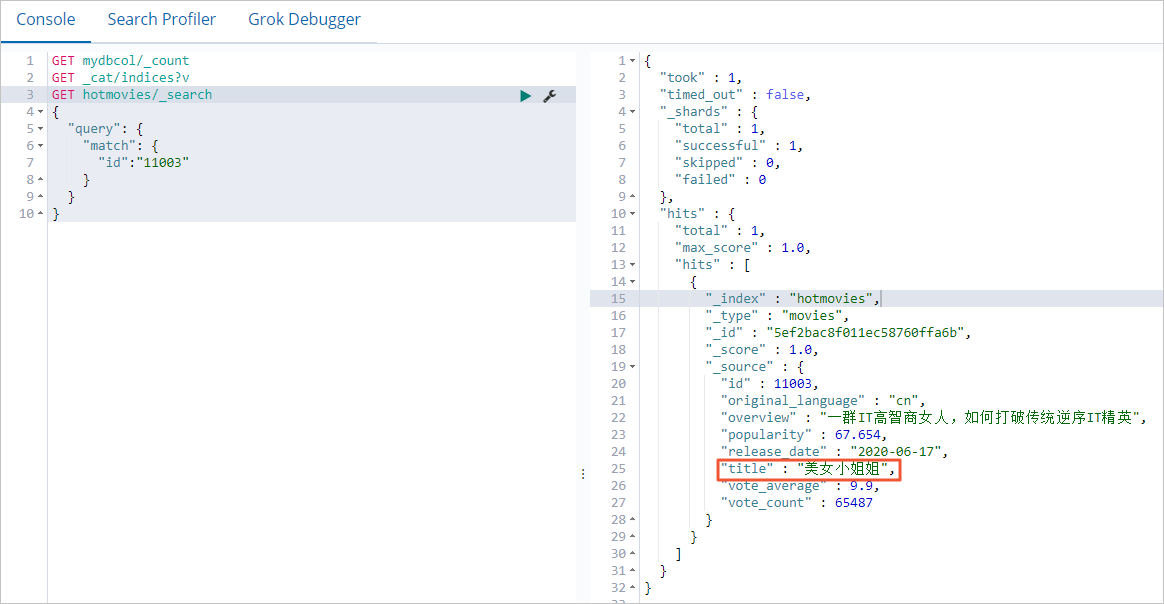
在MongoDB数据库中删除数据,查看阿里云Elasticsearch实例中对应的数据是否会同步删除。
MongoDB
db.hotmovies.remove({id: 11003}) db.hotmovies.remove({id: 11004})阿里云Elasticsearch
GET hotmovies/_search { "query": { "bool": { "should": [ {"term":{"id":"11003"}}, {"term":{"id":"11004"}} ] } } }预期结果如下。

步骤五:通过Kibana分析并展示数据
- 登录目标阿里云Elasticsearch实例的Kibana控制台,根据页面提示进入Kibana主页。登录Kibana控制台的具体操作,请参见登录Kibana控制台。说明 本文以阿里云Elasticsearch 6.7.0版本为例,其他版本操作可能略有差别,请以实际界面为准。
创建索引模式。
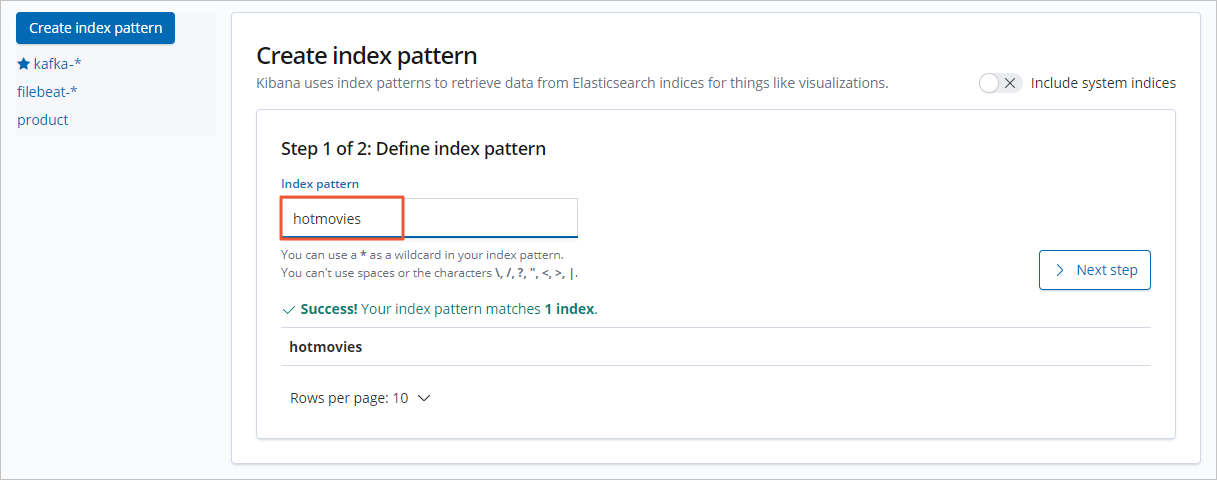
- 在左侧导航栏,单击Management。
- 在Kibana区域,单击Index Patterns。
- 单击Create index pattern。
- 输入Index pattern名称,单击Next step。
从Time Filter field name中,选择时间过滤器字段名(本文选择I don't want to use the Time Filter)。
- 单击Create index pattern。
配置Kibana大图。
本文以配置最受欢迎的Top10电影的Pie图为例,操作步骤如下:
在左侧导航栏,单击Visualize。
在搜索框右侧,单击+。
在New Visualization对话框中,单击Pie。
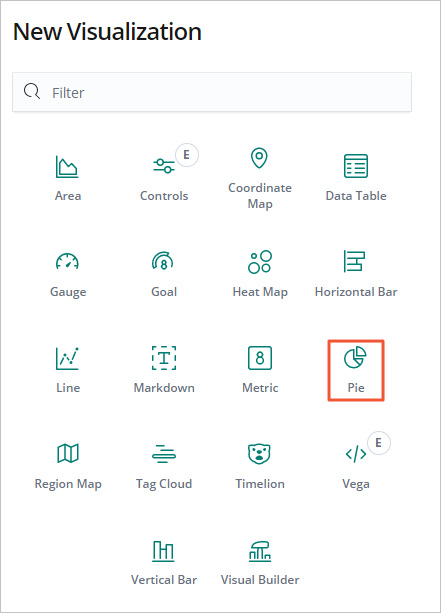
单击hotmovies索引模式。

按照下图配置Metrics和Buckets。
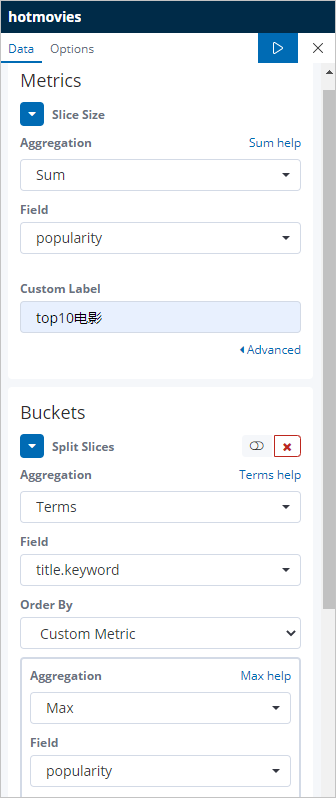
单击
 图标,应用配置,查看数据展示结果。
图标,应用配置,查看数据展示结果。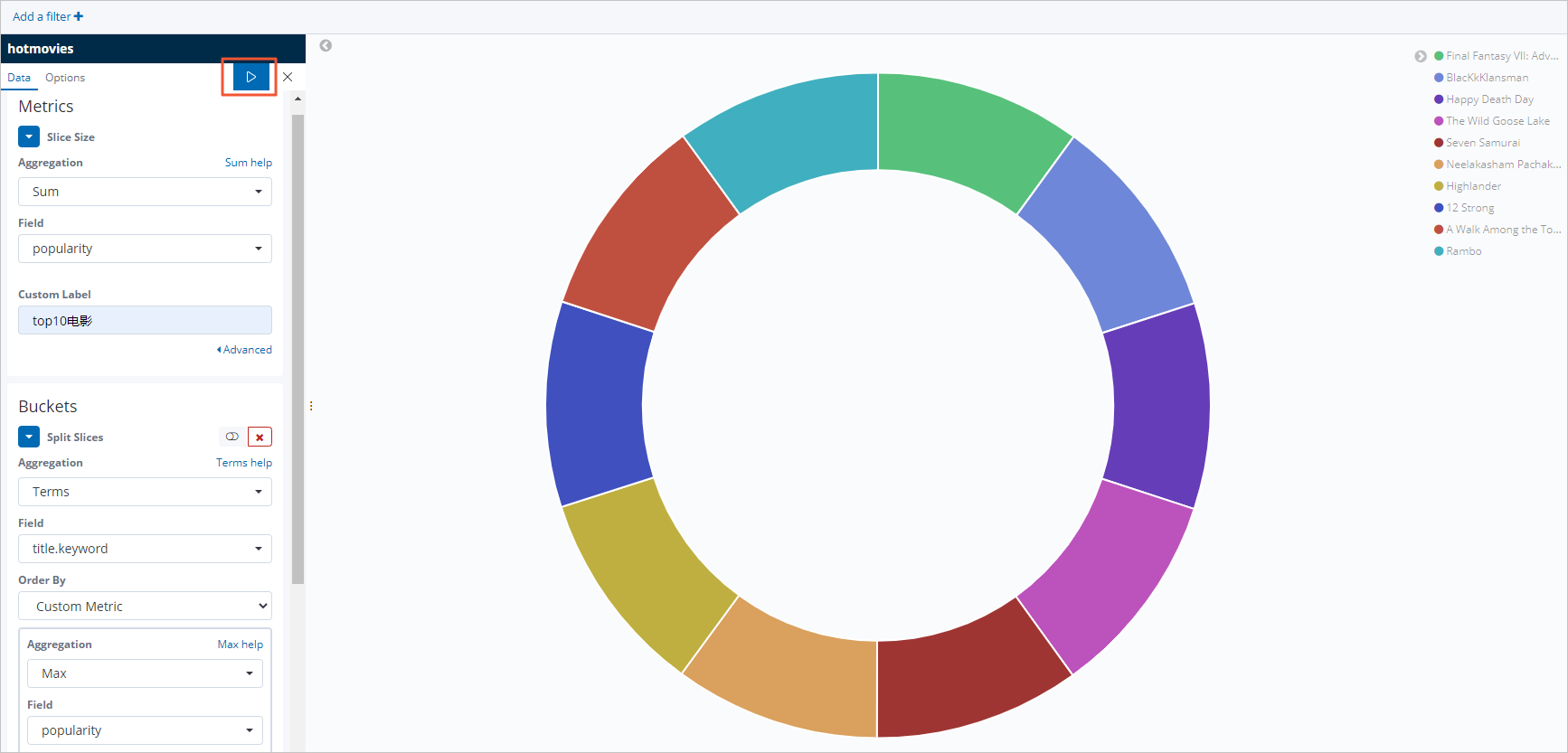
常见问题
问题
阿里云Elasticsearch实例开启高可用、高并发功能后,数据有丢失现象,如何排查?
解决方案
查看阿里云Elasticsearch集群的整体情况是否正常:
正常:需要排查Monstache服务的问题,详细信息请参见Monstache官网。
不正常:参见常见问题,排查阿里云Elasticsearch集群的问题。同时降低并发数,观察数据是否正常。
